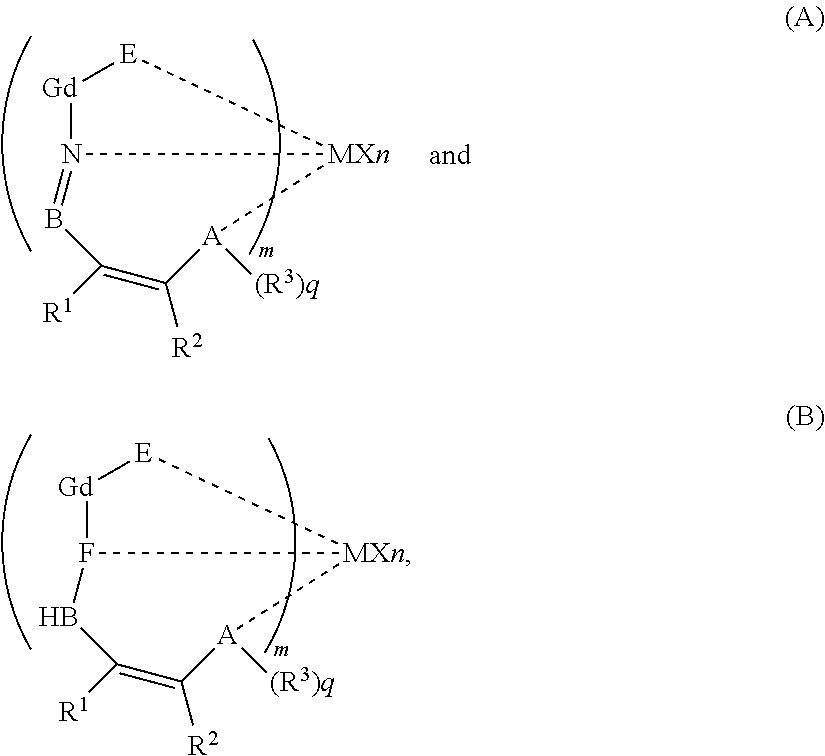Supported nonmetallocene catalyst, preparation and use thereof
a nonmetallocene catalyst and catalyst technology, applied in the field of nonmetallocene catalysts, can solve the problems of high consumption of methyl aluminoxane, short service life, low or high molecular weight, etc., and achieves the effect of easy adjustment of composition and amount of essential materials, high activity in copolymerization, and relatively strong bonding between essential materials in catalysts
- Summary
- Abstract
- Description
- Claims
- Application Information
AI Technical Summary
Benefits of technology
Problems solved by technology
Method used
Image
Examples
example
[0293]The present invention is further illustrated by using the following examples, not limiting to same.
[0294]The bulk density of the polymer was measured according to the Chinese Standard GB 1636-79 (unit: g / cm3).
[0295]The content of the Group IVB metal (for example Ti) and the content of the Mg element in the supported nonmetallocene catalyst were determined by the ICP-AES method, while the content of the nonmetallocene ligand was determined by the element analysis method.
[0296]The polymerization activity of the catalyst was calculated as follows.
[0297]Upon completion of the polymerization, the polymer product in the reactor was filtered and dried, and then weighed for its weight (by mass). Then, the polymerization activity of the catalyst was expressed by a value obtained by dividing the weight of the polymer product by the weight (by mass) of the supported nonmetallocene catalyst used (unit: kg polymer per 1 g Cat).
[0298]The molecular weights Mw, Mn and the molecular weight dis...
example i
Corresponding to the First Embodiment
Example I-1
[0302]Anhydrous magnesium chloride was used as the magnesium compound, tetrahydrofuran was used as the solvent for dissolving the magnesium compound and the nonmetallocene complex, silica gel (ES757, from the Ineos Company) was used as the porous carrier, the compound represented by
was used as the nonmetallocene complex.
[0303]The silica gel was thermally activated by continuously calcinating at 600° C. under a N2 atmosphere for 4 hours before use.
[0304]5 g of the anhydrous magnesium chloride and the nonmetallocene complex were weighted, tetrahydrofuran was added thereto to completely dissolve same at the normal temperature. Then, the thermally activated silica gel was added thereto, after stirring for 2 hours, the resultant was uniformly heated to 90° C. and directly vacuum dried, to obtain the supported nonmetallocene catalyst.
[0305]In this example, the ratio of magnesium chloride to tetrahydrofuran was 1 mol:210 ml, the ratio by mola...
example i-2
[0307]Substantially the same as the Example I-1, except for the following changes:
[0308]The porous carrier was changed to silica gel (955, from the Grace Company), which has been thermally activated by continuously calcinating at 400° C. under a N2 gas atmosphere for 8 hours.
[0309]The nonmetallocene complex was changed to
the solvent for dissolving the magnesium compound and the nonmetallocene complex was changed to toluene, and the magnesium compound solution was vacuum dried at 100° C.
[0310]In this example, the ratio of the magnesium compound to toluene was 1 mol:150 ml, the ratio by molar of the magnesium compound to the nonmetallocene complex was 1:0.15, and the ratio by weight of the magnesium compound to the porous carrier was 1:4.
[0311]The thus obtained supported nonmetallocene catalyst was named as CAT-I-2.
PUM
| Property | Measurement | Unit |
|---|---|---|
| crosslinking degree | aaaaa | aaaaa |
| crosslinking degree | aaaaa | aaaaa |
| temperature | aaaaa | aaaaa |
Abstract
Description
Claims
Application Information
 Login to View More
Login to View More - R&D
- Intellectual Property
- Life Sciences
- Materials
- Tech Scout
- Unparalleled Data Quality
- Higher Quality Content
- 60% Fewer Hallucinations
Browse by: Latest US Patents, China's latest patents, Technical Efficacy Thesaurus, Application Domain, Technology Topic, Popular Technical Reports.
© 2025 PatSnap. All rights reserved.Legal|Privacy policy|Modern Slavery Act Transparency Statement|Sitemap|About US| Contact US: help@patsnap.com



